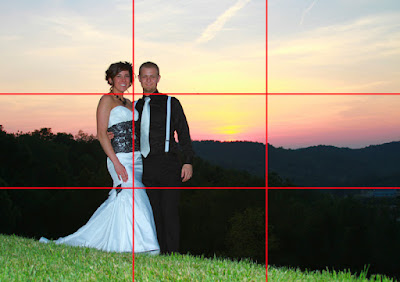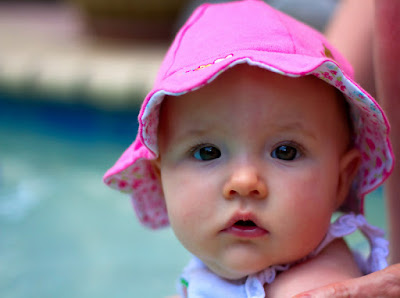 It's important to consider composition when taking a photograph, and one of the ways to do this is by determining where you plan to position your subject(s). An ideal way to make your photo more interesting or appealing to the eye is to utilize the "Rule of Thirds." The Rule of Thirds is a guideline that will help you create balanced, off-center photographs.
It's important to consider composition when taking a photograph, and one of the ways to do this is by determining where you plan to position your subject(s). An ideal way to make your photo more interesting or appealing to the eye is to utilize the "Rule of Thirds." The Rule of Thirds is a guideline that will help you create balanced, off-center photographs. As you look through your viewfinder, imagine there are lines dividing your image into thirds, both vertically and horizontally, thus dividing your image into nine equal parts (as shown in the above image). If you place important picture elements on these lines (or preferably on their intersection points) rather than in the middle of your image, you will end up with a more balanced and visually appealing design.

This rule works well for both vertical and horizontal pictures since the sections are equal in size.
Note, however, that while placing your subject(s) off-center has its visual advantages, there are certain situations when you will want to center the important details (or your subjects) within a photograph. Experiment with the Rule of Thirds next time you are taking photos, and see how utilizing this technique can add dimension and interest to your image.
Please feel free to comment on examples in which utilizing the rule of thirds worked well for you or didn't add a significant amount of visual stimulation within your picture. Also feel free to add any additional information that may contribute to utilizing this technique when photographing.

Does using the rule of thirds allow for the "blurred" background in the baby picture? I love how the indistinguishable background, really makes the subject pop.
ReplyDeleteThe aperture value is, in fact, what allowed me to blur the background in this particular photo. (I explained a little bit about aperture in the email I just sent you :) but I'll cover a little bit about it here for others who may be reading). Aperture (f-stop) is the lens diaphragm opening inside a photographic lens, and the size of the opening regulates the amount of light that passes through onto the film inside the camera the moment when the shutter curtain in your camera opens during an exposure process. The lower the f-stop, the greater the aperture (meaning more light is allowed to pass through - it's considered wide-open). Adjusting the aperture allows for a varying depth of field. So, if you choose to use a low aperture value or f-stop (wide-open), then you'll have a very shallow depth of field, which will, in fact, blur the background for you. In this photo I choose to set my aperture to f/1.8 (very wide open). The picture at the top had an aperture setting of f/7.0, which allowed more of the background to be in focus. I do want to add here though that by applying the rule of thirds in the picture of the baby with a wide open aperture, really allowed the baby to stand out (be the main focus of the picture). I might not have had the same (or such a profound) effect had I positioned the baby in the center of the image.
ReplyDelete